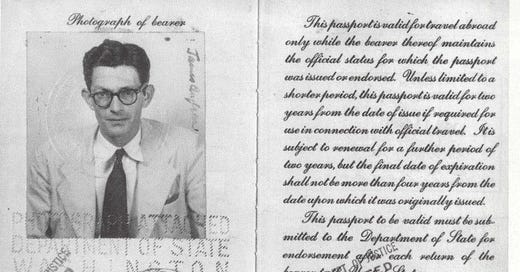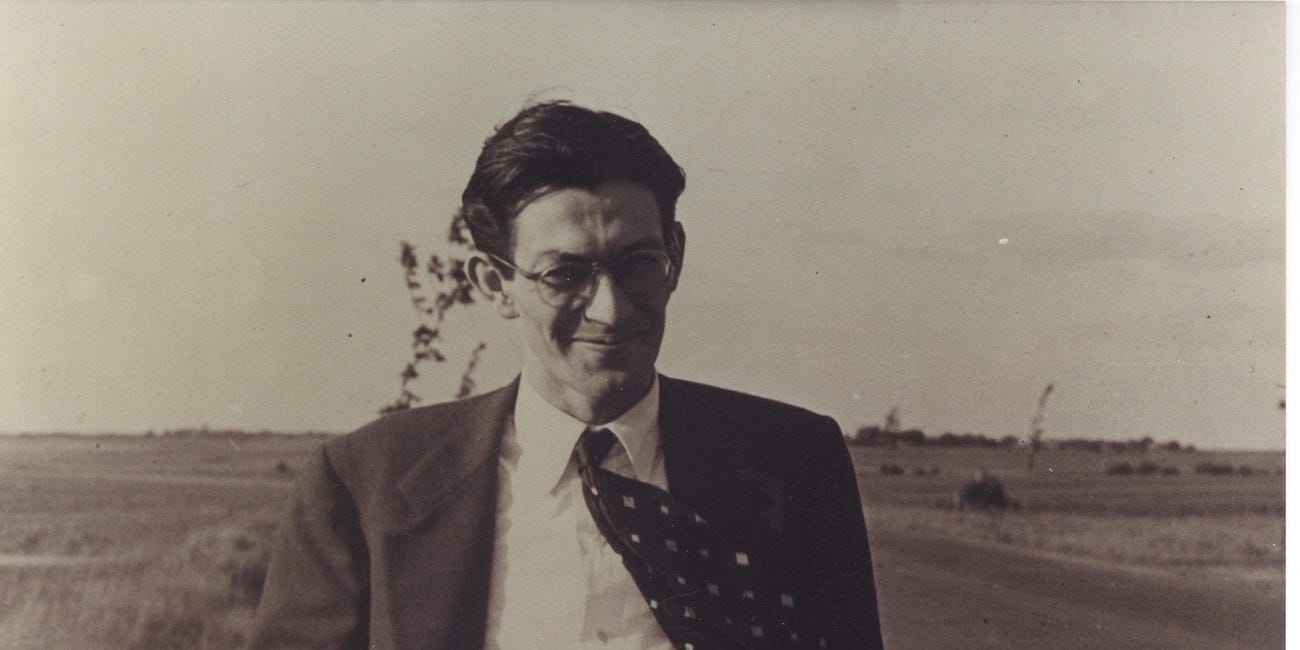James Jesus Angleton, Furioso, the Modernist Avant-garde
The Early Days of the Central Intelligence Agency
Crew of the USS Tom Clancy,
For this dispatch, I’m sending along a paper I wrote for my LatinX Literature class on my favorite LatinX Poet, James Jesus Angleton
I’ve written about Angleton several times for The Hunt for Tom Clancy — there’s this dispatch:
Orchids for Mother
Yesterday afternoon my Mother and I planted some tomatoes, beets and french breakfast radish in her garden, along with some seeds I’d brought from Monticello; Corn Poppies, Refugee/Swiss Gray beans, Blue-podded Capucijner Pea Seeds, a Money Plant. Speaking of Money Plants, we know it doesn’t grow on trees or plants, and is difficult to part with. That’s…
Then there’s this dispatch:
And of course, the examination of a novel about an Angleton figure, written by a journalist cultivated by Angleton.
Orchids for Mother
“People in our business don’t grow up. Especially my generation. We were college boys when we joined the OSS, and it seemed like a fraternity. We weren’t so much fighting the enemy as hazing him. Playing pranks on him. Like collecting all that pornography to drop on Hitler. Then that collegiate tone carried over from the OSS into the CIA. You must’ve seen it: Langley’s New Haven all over again right down to Nathan Hale.”
Jim Angleton left his middle name, Jesus, off his security clearance form in 1949. The man responsible for ferreting out spies operating under the cover of deception was himself deceptive. He’d started out in poetry, editing a hot literary magazine at Yale, and then found himself—with the war on and all—drawn to intrigue.
He joined the Office of Strategic Services (OSS), was stationed in London and Italy and distinguished himself as an intelligence officer. The summer of 1949, as he was vetted to join the newly formed Central Intelligence Agency, there were a few facts about himself James Jesus Angleton seemed to want to obscure.
The form was a precursor to modern security clearance forms –known as Form No 38-1, Sept 1948—it looked like the following. This is how the CIA’s eventual chief of counterintelligence answered the questions it posed.
PERSONAL HISTORY STATEMENT
Answer all questions completely. If question does not apply write “not applic-
Able” Write “unknown” only if you do not know the answer and cannot obtain the answer from personal records. Use the blank pages at the end of this form for extra details on any questions or question for which you do not have sufficient room.
Type, print or write carefully; illegible or incomplete forms will not receive consideration
HAVE YOU READ AND DO YOU UNDERSTAND THE INSTRUCTIONS? YES
Telephone
Office: Executive 6115
A: FULL NAME Mr. James Angleton Ext. 2011
First Middle Last Home: OVerlook 1619
And then again, there’s Section 27. I CERTIFY THAT THE FOREGOING ANSWERS ARE TRUE AND CORRECT TO THE BEST OF MY KNOWLEDGE AND BELIEF AND I AGREE THAT ANY MISSTATEMENT OR OMISSION AS TO A MATERIAL FACT WILL CONSTITUTE GROUNDS FOR IMMEDIATE DISMISSAL OR REJECTION OF MY APPLICATION.
This is followed by the signature portion of the document, where Angleton again leaves off Jesus, denies his middle name. He signs the document James Angleton, dated 16 July 1949.
On that day, if the Catholic mother—Carmen Mercedes Moreno Angleton—of the Episcopalian James Angleton attended Mass, it was the Feast Day for Our Lady of Mount Carmel.
Mrs. Carmen Mercedes Moreno Angleton was born in Mexico on 19 May 1898, her US Citizenship acquired by marriage in Nogales, Arizona, where she was naturalized by marrying Jim’s father. Jim’s father was James Hugh Angleton, who’d ridden with General Pershing during the punitive expeditions against Pancho Villa, who was originally from Illinois.
In garrison in Arizona, James Hugh Angleton met the 17-year old Carmen Mercedes Moreno and married her. A year later, two months after the Russian Revolution, she would give birth to her first son, James Jesus Angleton in Boise, Idaho, where her husband was working as an executive for the National Cash Register Corporation. The mother of James Jesus, had she been in mass the day her son sent in the security clearance form denying his middle name, would’ve heard a reading from Psalm 18 and Matthew 17:40 from the priest.
In those passages, specifically, she would have heard scripture with echoes for the new career her poet son. This was the son that, though Christened James Jesus Angleton upon his birth in Boise, Idaho, was choosing to continue to hide or obscure his LatinX identity. This concealment was a consistent part of Angleton’s life from the time they moved from Idaho, he never used the middle name Jesus, at least professionally.
An FBI report from Butte Montana made by Special Agent David W. Murray, as part of Angleton’s background check, plainly states the full name Jim tried to hide, based on birth records.
Applicant born Boise, December 9, 1917, with recorded name listed as JAMES JESUS ANGLETON. Former friends and business associates of family furnished nothing derogatory. Family left Boise about 1925 while Applicant a youngster, and loyalty and patriotism unquestioned. (Angleton FBI Report)
Owing to Angleton’s collegiate associations, there would be some other questions of foreign influence on the young spy; none of the security investigators are concerned about Angleton’s Mexican roots, although they do note that his aunt was married to a German living in California who may have been a foreign agent member of the Bund.
Another concern was that one of Angleton’s favorite poets—given many column inches in Angleton and Reed Whittemore’s college literary magazine, Furioso, was also a propagandist for Mussolini.
An FBI report from New Haven, Connecticut on 9/16/1949 confirms Angleton was drawn to another poet from Idaho while a student at Yale. Reed Whittemore, who would go on to be a long time English professor at Carleton college, would revive Furioso in 1949, the same year Angleton went fully into intelligence.
RL PURDY, English Professor at Yale, advised ANGLETON was partial to advanced thinkers, such as EZRA POUND. (Angleton FBI report)
The report notes further that Angleton was associated with Pound, sure, but not in any way that should disrupt his ability to operate for a secret US government entity doing highly sensitive counter-espionage work. The source for this is the English professor that first trained Angleton as a spy:
NORMAN H. PEARSON, Assistant Professor of English at Yale University, advised that he has known ANGLETON since 1941 when he was a student at Yale, and that he has known him personally since 1943…PEARSON stated that ANGLETON had been an editor of a poetry magazine entitled “FURIOSO” and that as such he had used a large amount of EZRA POUND in his selection of authors. PEARSON stated that ANGLETON had discontinued POUND when he realized that it was understood that POUND was pro-Fascist. (Angleton FBI report)
Though Angleton’s association with Pound was interrogated heavily though out the ninety plus pages of FBI security files, his decision to not sign his middle name was critical to understanding the man. This is no simple slip of the pen; there are numerous small details filled in on the form, including his mother’s Mexican heritage, but not the nominative evidence of that: his middle name, Jesus.
As CIA historian David Robarge notes in a footnote to his long monograph The James Angleton Phenomenon:
One persistent misunderstanding about Angleton to dispense with straight away involves his middle name, Jesus. Practically everyone who writes or talks about Angleton uses it — to what end is unclear — but he never did, and as an Anglophile, he avoided calling attention to that prominent reminder of his half-Mexican parentage. He always signed documents just with “James Angleton,” in a crabbed, slightly shaky script that would fascinate graphologists. (Robarge, footnote 6)
This was, it appears, the case professionally but not personally. Even professionally, though, Angleton seemed to embrace allusions to his heritage, at least obliquely: why, if he was ashamed of his mother, else would one of his pseudonyms or codenames used in place of his true name throughout the Agency be Mother? Angleton, who’d married into a wealthy Tucson family, still maintained ties to the American southwest and the intermountain west.
Notably, his grave is not at Arlington (where contemporaries Frank Wisner and Richard Helms are buried) or Yale or even on the east coast at all—Angleton is buried near his mother and father in Boise, Idaho. The grave is still decorated with Orchids—Angleton’s favorite flower—by someone.
After his death, Angleton’s son—also named James—would deny his father was ashamed of, or sought to conceal, his Mexican Heritage. In a letter to the Los Angeles Times after biographer Jefferson Morley wrote an article, Angleton’s son James C responded that the writer:
“delivers one of the lowest blows so far to my father’s reputation. My father was half Mexican and proud of it. I base this statement on a 42-year association. Yet Morley writes that my father possessed an “antipathy to all things Mexican” and felt “ashamed” of his Mexican heritage.
Nor does the article point out that my father vacationed in Mexico and was gratified to meet and talk with his Mexican relatives at a family reunion held during the last year of his life.” (LA Times JAMES C. ANGLETON)
That may well have been true, behind closed doors at James Jesus Angleton’s home in Arlington, Virginia. It also remains true that during his professional career, Angleton leaned—openly—more into the Anglo side of his identity than the Mexican side, as we see from his security clearance form. This bifurcation of identity is not uncommon for spies.







